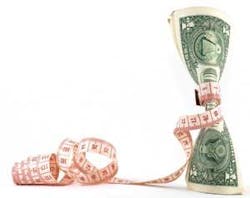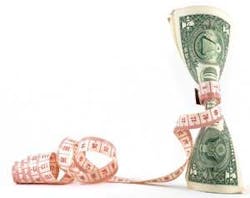Strategies for tighter times: The right marketing and sales messages for today’s customers
By John Graham
There’s no lack of words by which to live. These range from good advice such as, “On the keyboard of life, always keep one finger on the escape key,” to the deviously practical, “By the time you can make ends meet, they move the ends.”
Sales and marketing professionals, who must do battle in an economic environment where all types of buyers are bedeviled by financial pressures, can benefit from words to work by. Here’s a checklist of eight words that send the right message to today’s customers:
1. Security. Avoiding unnecessary risk is on everyone’s mind. Today, even seemingly small mistakes can lead to unemployment. You know the environment is treacherous when high visibility CEOs head for a last limo ride.
The common question is “What are the implications if I make this buying decision?” That’s why addressing it with customers is key to closing sales. It’s a lesson straight out of the IBM playbook of the late ‘80s and early ‘90s. Because the brand was so highly regarded, buyers felt safe buying IBM.
It’s also why the Toyota Matrix outsells the Pontiac Vibe, even though they come off the same assembly line. The Toyota brand is held in higher regard.
From the get-go, help customers understand why it’s safe to buy your product or service.
2. Agility. In the book “Blown to Bites,” the authors point out that a lack of “legacy systems, legacy assets and legacy mindsets” gives companies an advantage today. Contrary to how it may seem, two of today’s most agile industries are real estate and restaurants. Rather than stand by and hope for the best, both responded quickly and creatively to the economic slowdown.
Instead of trying to talk consumers into changing their thinking about the housing situation, real estate companies changed their advertising almost instantly. In print and on the Internet, ads featured much lower priced homes in many communities. They didn’t need headlines to say that prices were dropping; they portrayed the story.
So, too, from fast foods to fine dining, restaurants advertised interesting menus at lower prices. They created buzz by bringing consumers something “new and different” without discounting.
Instead of wait and die, the strategy should be move quickly and survive.
3. Productivity. “In the coming era,” wrote Kevin Kelly, Senior Maverick at Wired magazine, “doing the exactly right next thing is far more fruitful than doing the same thing twice.” This may be the only definition of productivity that really makes sense today. It suggests that the “doing it right” mentality is dangerous, dead-end thinking. This inevitably leads to the conclusion that getting it right (whatever that happens to be) is enough.
There’s a powerful message here for marketing and sales, namely, position your product or service in terms of continuous productivity improvement. “We’re not only going to help you increase productivity now, but we’re going to help you over the long term.”
A dramatic example of this approach is the Apple iPhone. From the start, it has been portrayed as a self-improving product, rather than “here’s the latest and the greatest gizmo,” which is the usual approach.
4. Convenience. Inchworm (inchworm.com) shoes for kids are actually three sizes in one shoe. When the shoe is shown to a group, everyone with children asks, “Where can I get them?” No one asks about the price. The Inchworm message is clear: convenience, no more running to the shoe store every six weeks.
With time in as short supply as money, anything that promotes convenience sends a powerful message.
5. Leadership. It didn’t take long for auto manufacturers to jump on the hybrid bandwagon. But so far Toyota, the first to introduce dual-energy vehicles, is the perceived leader, with Prius taking 51.2% of the segment’s market share in 2007.
Toyota hybrids deliver on the promise of greater fuel efficiency, illustrating that leadership is all about performance. When it comes right down to it, we recognize leadership when we see it, not when someone talks about it.
Whether it’s delivering on promises or helping buyers be more successful, the task is to draw a picture of leadership that captivates customers.
6. Savings. Whenever we buy from a salesperson, there’s a gnawing fear that the purchase will benefit the person making the sale more than us, the buyers. In tighter times, this fear seems far more pervasive.
Unless the salesperson makes a point of addressing the cost-saving benefits of the purchase, the sale is probably in jeopardy. Take computer monitors as an example. According to Jon Peddie Research, no matter how we measure productivity, adding a second monitor gives workers a productivity boost of 20% to 30%. In any office, the savings mean more work from fewer employees.
The goal is to help customers understand how appropriate purchases can be the right step for reducing their operating costs.
7. Reliability. Whether it’s a trend isn’t clear, but some companies that jumped into outsourcing services overseas a few years ago are bringing them home, and for good reason: customers complain that the service is unreliable.
In the same way, Circuit City fired its competent, well trained and highly paid hourly salespeople, the backbone of the business, to cut costs. They replaced valuable employees who were adept at serving customers with young, poorly trained part-timers. Is there a connection between the unreliable work force and the company’s serious financial problems?
Whether it’s the reliability of equipment or service, showing customers that they can count on you is the key to continuing sales.
8. Value. A man whose father died when he was a kid looked back on his childhood with some amazement. “My mother and I were poor by any standards,” he said. “Yet she bought me expensive Selby Arch Preserver shoes. She said they were better for my feet and didn’t wear out so fast.” Even when many people are buying down, there is a significant segment that relates to value, people who want their purchases to last.
Apple’s computer sales figures are a case in point. NPD Market Research data shows that Apple’s share of the PC market grew from 9% in February 2007 to 14% a year later, just at the time when there was both a decline in overall PC sales and, most importantly, prices. Yet Apple’s prices are higher than other brands, particularly with laptops.
It’s easy to be seduced into believing that price is all that customers care about. It isn’t true. It’s what price represents that makes the difference.
Words count because they symbolize crucial issues, and words that capture what customers think keep us focused on the right issues – if we want to make sales in these tight times.
John R. Graham is president of Graham Communications, a marketing services and sales consulting firm. He writes for a variety of business publications, and speaks on business, marketing and sales issues. Contact him at 40 Oval Road, Quincy, MA 02170, (617) 328-0069, or [email protected]. The company’s Web site is grahamcomm.com.

